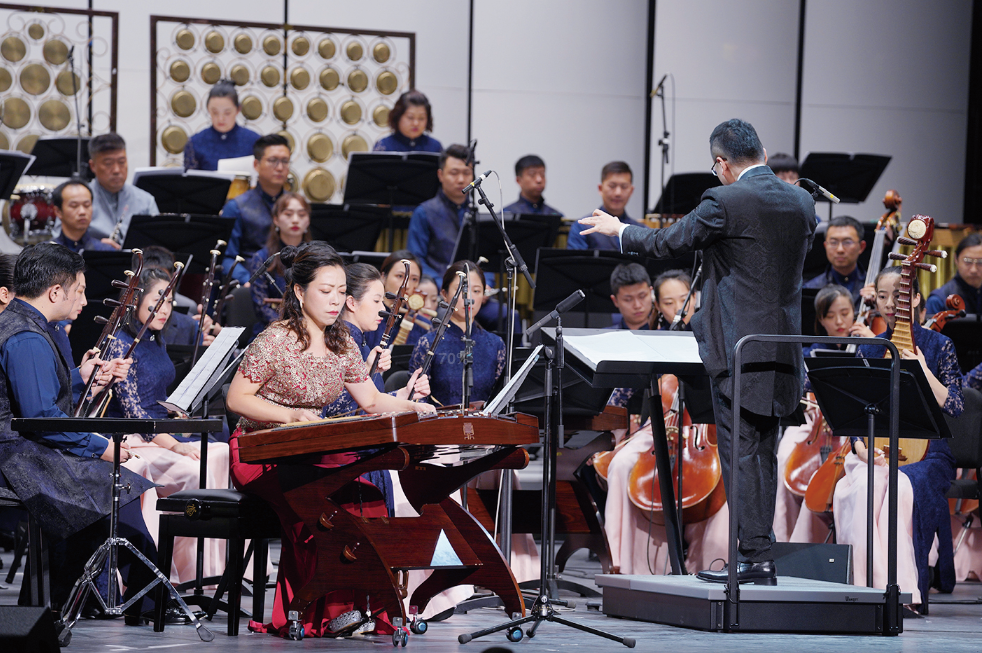Cao Yun: Re-training, not re-engraving.
In the face of the new crown pneumonia epidemic, in order to encourage players to "practice non-stop", the Shanghai Chinese Orchestra has specially arranged difficult solo works for each part that reflect the contemporary performance level. Among them, the designated work for the dulcimer part is the dulcimer concerto Rhapsody written by composer Wang Danhong in 2011. As the principal of the dulcimer section of the Shanghai Chinese Orchestra, Cao Yun has deep feelings for this piece. He will record his experience of practicing the piano at home and share it with readers.
This piece is now a compulsory work in the field of dulcimer, and has become one of the most frequently photographed dulcimer concertos on the contemporary concert stage. This piece is no stranger to Cao Yun. Recalling the first practice in 2015, it was to prepare for the orchestra's business exam every two years. I remember at the assessment site, a conductor on the jury had heard my performance and curiously asked Cao Yun what year he graduated from college. Perhaps in the eyes of many people, challenging new works seems to be the patent of young players. But all along, Cao Yun likes to challenge himself and try new works, both during his studies and now.

Played "Fantasy" again, this is the second time Cao Yun has practiced this song. The last time I re-trained, and it was staged in the orchestra's season concert, that scene is still in my mind. In fact, re-training a big work is not as easy as you think. After all, a considerable part of the technical aspects of instrumental playing rely on muscle memory. For many domestic and foreign performers, one of the secrets to maintaining piano skills is to maintain daily training. It can be said that "you know if you don't practice for one day, and the audience knows if you don't practice for three days." The daily basic skills training, for the masters, even if they have decades of skills, they dare not slack off. Looking back on being with Master Min Huifen in the past, under the immersive teaching, I can see how the Master's daily practice has benefited.
The process of re-training requires not only basic skills accumulated over time, but also technical problems in specific playing methods, musical expression, muscle control, etc., which are all a process of re-engineering. The first step in this process is to "be still and slow down", then think with your brain, feel with your heart, listen with your ears, and present with your hands. Of course, in the course of many years of teaching, Cao Yun also found that many students have such confusion: it is better to practice a new song instead of re-rehearsing a work. Cao Yun despised the reason for re-training. Cao Yun believes that most people do not read music correctly and seriously during re-training. Have you paid attention to every detail written by the composer in the score? Have the special signs made by the teacher (or yourself) been expressed? If you can accurately complete the carpet reading, the deep muscle memory you have practiced will be lost Will come out.
Retraining, not replicating. Cao Yun believes that if the basic skills accumulated over time are compared to the bottom layer of the pyramid, and the middle layer is to "slow down and slow down" to awaken the senses of the heart, brain, ears and hands, then what is the upper layer? With improvement and rich experience, each re-training will generate a new understanding and understanding of the work. Therefore, Cao Yun believes that the top layer of the pyramid is "sublimation". Sublimation cannot be measured simply by speed, but in terms of emotional expression of musical images, timbre, and control of tension. There is infinite space. Worth a boost.
Just like the Olympic spirit - higher, faster, stronger, the artistic presentation of music is never-ending, there is no perfection, there is no best, only better.
Involving musical instruments
Guess you like
Hot news
- 01 Ancient Legacy: The Legend of the creation of Emperor Shun and the Banjo
- 02 The handsome guy in 1997 is so advanced in pulling erhu! Netizen: Come and "wash your ears"
- 03 Dulcimer exam and performance repertoire
- 04 The difference between the five-stringed lute and the four-stringed lute
- 05 The Simple Difference Between Guqin, Se, and Guzheng
 渝公网安备 50010702504639号
渝公网安备 50010702504639号